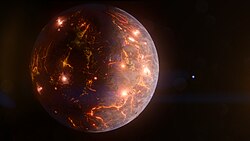Astronomy:LP 791-18
| Observation data Equinox J2000.0]] (ICRS) | |
|---|---|
| Constellation | Crater[1] |
| Right ascension | 11h 02m 45.95462s[2] |
| Declination | −16° 24′ 22.2882″[2] |
| Apparent magnitude (V) | 16.9±0.2[3] |
| Characteristics | |
| Evolutionary stage | Red dwarf (main sequence) |
| Spectral type | M6.1±0.7V[3] |
| Astrometry | |
| Proper motion (μ) | RA: -221.291[2] mas/yr Dec.: -58.841[2] mas/yr |
| Parallax (π) | 37.5225 ± 0.0392[2] mas |
| Distance | 86.92 ± 0.09 ly (26.65 ± 0.03 pc) |
| Details[3] | |
| Mass | 0.139±0.005 M☉ |
| Radius | 0.17±0.018 R☉ |
| Temperature | 2960±55 K |
| Metallicity [Fe/H] | -0.09±0.19 dex |
| Age | 0.5±0.064 Gyr |
| Other designations | |
| Database references | |
| SIMBAD | data |
LP 791-18 (TOI-736) is a cool M dwarf star in the constellation Crater, located 26.65 parsecs (86.9 light-years) away from Earth.[3]
The star is one of the smallest known to host exoplanets.[5] In 2019 two exoplanets in transit around it were announced by TESS,[3] and a third planet was discovered in Spitzer Space Telescope data in 2023.[5]
Planetary system

The innermost planet, b, is a super-Earth and the outermost planet, c, is a mini-Neptune. They were discovered together in 2019.[3] The middle planet, d, is an Earth-mass world discovered in 2023. It may potentially be tidally heated by interactions with planet c, which would lead to abundant volcanoes similar to Jupiter's moon Io.[5] As the planet d is in the inner edge of the habitable zone, liquid water could condense on the side of the planet that faces away from the host star.[6]
In 2021 planet c was suggested for atmospheric analysis by the James Webb Space Telescope.[7]
| Companion (in order from star) |
Mass | Semimajor axis (AU) |
Orbital period (days) |
Eccentricity | Inclination | Radius |
|---|---|---|---|---|---|---|
| b | — | 0.00978±0.00012 | 0.9479981±0.0000021 | — | 88.37+0.94−0.95° | 1.212+0.059−0.058 R⊕ |
| d | 0.9+0.5−0.4 M⊕ | 0.01992±0.00014 | 2.753436±0.000013 | 0.0015±0.00014 | 89.34±0.41° | 1.032+0.044−0.043 R⊕ |
| c | 7.1±0.7 M⊕ | 0.02961+0.00035−0.00036 | 4.9899093+0.0000074−0.0000072 | 0.00008±0.00004 | 89.78±0.13° | 2.438±0.096 R⊕ |
References
- ↑ "Finding the constellation which contains given sky coordinates". 2 August 2008. http://djm.cc/constellation.html.
- ↑ 2.0 2.1 2.2 2.3 Vallenari, A. et al. (2022). "Gaia Data Release 3. Summary of the content and survey properties". Astronomy & Astrophysics. doi:10.1051/0004-6361/202243940 Gaia DR3 record for this source at VizieR.
- ↑ 3.0 3.1 3.2 3.3 3.4 3.5 "A Super-Earth and Sub-Neptune Transiting the Late-type M Dwarf LP 791-18". The Astrophysical Journal Letters 883 (1): L16. 2019. doi:10.3847/2041-8213/ab3d30. Bibcode: 2019ApJ...883L..16C.
- ↑ "LP 791-18". SIMBAD. Centre de données astronomiques de Strasbourg. http://simbad.u-strasbg.fr/simbad/sim-basic?Ident=LP+791-18.
- ↑ 5.0 5.1 5.2 5.3 "A temperate Earth-sized planet with tidal heating transiting an M6 star.". Nature 617 (7962): 701–705. 2023. doi:10.1038/s41586-023-05934-8. PMID 37198481. https://pubmed.ncbi.nlm.nih.gov/37198481.
- ↑ 6.0 6.1 Kazmierczak, Jeanette (16 May 2023). "NASA's Spitzer, TESS Find Potentially Volcano-Covered Earth-Size World". NASA. https://www.jpl.nasa.gov/news/nasas-spitzer-tess-find-potentially-volcano-covered-earth-size-world.
- ↑ "Detecting Biosignatures in the Atmospheres of Gas Dwarf Planets with the James Webb Space Telescope". The Astrophysical Journal 923 (2): 144. 2021. doi:10.3847/1538-4357/ac29be. Bibcode: 2021ApJ...923..144P.
 |


